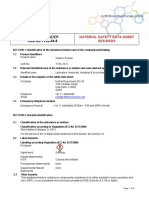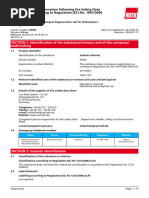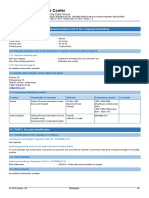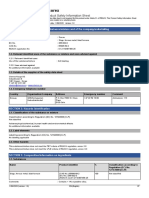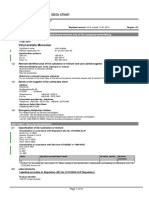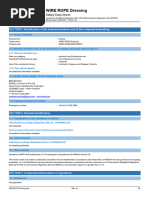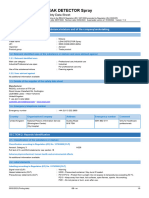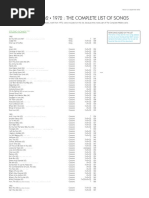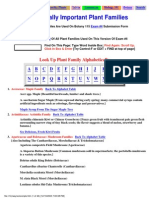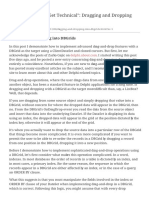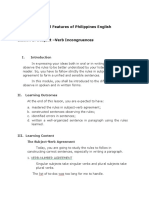SDB HN25 Ie en
SDB HN25 Ie en
Uploaded by
Tiara ChandraCopyright:
Available Formats
SDB HN25 Ie en
SDB HN25 Ie en
Uploaded by
Tiara ChandraOriginal Title
Copyright
Available Formats
Share this document
Did you find this document useful?
Is this content inappropriate?
Copyright:
Available Formats
SDB HN25 Ie en
SDB HN25 Ie en
Uploaded by
Tiara ChandraCopyright:
Available Formats
Safety data sheet
according to Regulation (EC) No. 1907/2006 (REACH)
Sodium thiosulphate ≥ 99%, p.a., anhydrous
article number: HN25 date of compilation: 2016-04-22
Version: 4.0 en Revision: 2021-11-04
Replaces version of: 2020-01-14
Version: (3)
SECTION 1: Identification of the substance/mixture and of the company/
undertaking
1.1 Product identifier
Identification of the substance Sodium thiosulphate ≥ 99%, p.a., anhydrous
Article number HN25
Registration number (REACH) 01-2119531537-38-xxxx
EC number 231-867-5
CAS number 7772-98-7
1.2 Relevant identified uses of the substance or mixture and uses advised against
Relevant identified uses: Laboratory chemical
Laboratory and analytical use
Uses advised against: Do not use for products which come into contact
with foodstuffs. Do not use for private purposes
(household).
1.3 Details of the supplier of the safety data sheet
Carl Roth GmbH + Co KG
Schoemperlenstr. 3-5
D-76185 Karlsruhe
Germany
Telephone:+49 (0) 721 - 56 06 0
Telefax: +49 (0) 721 - 56 06 149
e-mail: sicherheit@carlroth.de
Website: www.carlroth.de
Competent person responsible for the safety data :Department Health, Safety and Environment
sheet:
e-mail (competent person): sicherheit@carlroth.de
1.4 Emergency telephone number
Name Street Postal Telephone Website
code/city
National Poisons Information Beaumont Road Dublin 9 01 809 2166 https://
Centre www.poisons.ie/
Beaumont Hospital
SECTION 2: Hazards identification
2.1 Classification of the substance or mixture
Classification according to Regulation (EC) No 1272/2008 (CLP)
This substance does not meet the criteria for classification in accordance with Regulation No 1272/
2008/EC.
2.2 Label elements
Labelling according to Regulation (EC) No 1272/2008 (CLP)
not required
Ireland (en) Page 1 / 13
Safety data sheet
according to Regulation (EC) No. 1907/2006 (REACH)
Sodium thiosulphate ≥ 99%, p.a., anhydrous
article number: HN25
2.3 Other hazards
Results of PBT and vPvB assessment
According to the results of its assessment, this substance is not a PBT or a vPvB.
SECTION 3: Composition/information on ingredients
3.1 Substances
Name of substance Sodium thiosulphate
Molecular formula Na₂S₂O₃
Molar mass 158,1 g/mol
REACH Reg. No 01-2119531537-38-xxxx
CAS No 7772-98-7
EC No 231-867-5
SECTION 4: First aid measures
4.1 Description of first aid measures
General notes
Take off contaminated clothing.
Following inhalation
Provide fresh air. In all cases of doubt, or when symptoms persist, seek medical advice.
Following skin contact
Rinse skin with water/shower. In all cases of doubt, or when symptoms persist, seek medical advice.
Following eye contact
Rinse cautiously with water for several minutes. In all cases of doubt, or when symptoms persist, seek
medical advice.
Following ingestion
Rinse mouth. Call a doctor if you feel unwell.
4.2 Most important symptoms and effects, both acute and delayed
Symptoms and effects are not known to date.
4.3 Indication of any immediate medical attention and special treatment needed
none
Ireland (en) Page 2 / 13
Safety data sheet
according to Regulation (EC) No. 1907/2006 (REACH)
Sodium thiosulphate ≥ 99%, p.a., anhydrous
article number: HN25
SECTION 5: Firefighting measures
5.1 Extinguishing media
Suitable extinguishing media
co-ordinate firefighting measures to the fire surroundings
water, foam, alcohol resistant foam, dry extinguishing powder, ABC-powder
Unsuitable extinguishing media
water jet
5.2 Special hazards arising from the substance or mixture
Non-combustible.
Hazardous combustion products
In case of fire may be liberated: Sulphur oxides (SOx)
5.3 Advice for firefighters
In case of fire and/or explosion do not breathe fumes. Fight fire with normal precautions from a reas-
onable distance. Wear self-contained breathing apparatus.
SECTION 6: Accidental release measures
6.1 Personal precautions, protective equipment and emergency procedures
For non-emergency personnel
Control of dust.
6.2 Environmental precautions
Keep away from drains, surface and ground water.
6.3 Methods and material for containment and cleaning up
Advice on how to contain a spill
Covering of drains. Take up mechanically.
Advice on how to clean up a spill
Take up mechanically.
Other information relating to spills and releases
Place in appropriate containers for disposal.
6.4 Reference to other sections
Hazardous combustion products: see section 5. Personal protective equipment: see section 8. Incom-
patible materials: see section 10. Disposal considerations: see section 13.
Ireland (en) Page 3 / 13
Safety data sheet
according to Regulation (EC) No. 1907/2006 (REACH)
Sodium thiosulphate ≥ 99%, p.a., anhydrous
article number: HN25
SECTION 7: Handling and storage
7.1 Precautions for safe handling
No special measures are necessary.
Advice on general occupational hygiene
Keep away from food, drink and animal feedingstuffs.
7.2 Conditions for safe storage, including any incompatibilities
Store in a dry place. Keep container tightly closed.
Incompatible substances or mixtures
Observe hints for combined storage.
Consideration of other advice:
Ventilation requirements
Use local and general ventilation.
Specific designs for storage rooms or vessels
Recommended storage temperature: 15 – 25 °C
7.3 Specific end use(s)
No information available.
SECTION 8: Exposure controls/personal protection
8.1 Control parameters
National limit values
Occupational exposure limit values (Workplace Exposure Limits)
Coun Name of agent CAS No Identifi- TWA STEL Ceil- Nota- Source
try er [mg/ [mg/ ing-C tion
m³] m³] [mg/
m³]
IE dusts non-specific OELV 10 i S.I. No. 619
of 2001
IE dusts non-specific OELV 4 r S.I. No. 619
of 2001
Notation
Ceiling-C Ceiling value is a limit value above which exposure should not occur
i Inhalable fraction
r Respirable fraction
STEL Short-term exposure limit: a limit value above which exposure should not occur and which is related to a 15-
minute period (unless otherwise specified)
TWA Time-weighted average (long-term exposure limit): measured or calculated in relation to a reference period of 8
hours time-weighted average (unless otherwise specified)
Human health values
Relevant DNELs and other threshold levels
Endpoint Threshold Protection goal, Used in Exposure time
level route of exposure
DNEL 374 mg/m³ human, inhalatory worker (industry) chronic - systemic effects
Ireland (en) Page 4 / 13
Safety data sheet
according to Regulation (EC) No. 1907/2006 (REACH)
Sodium thiosulphate ≥ 99%, p.a., anhydrous
article number: HN25
Environmental values
Relevant PNECs and other threshold levels
End- Threshold Organism Environmental com- Exposure time
point level partment
PNEC 0,8 mg/l aquatic organisms freshwater short-term (single instance)
PNEC 0,08 mg/l aquatic organisms marine water short-term (single instance)
PNEC 102,6 mg/l aquatic organisms sewage treatment plant short-term (single instance)
(STP)
8.2 Exposure controls
Individual protection measures (personal protective equipment)
Eye/face protection
Use safety goggle with side protection.
Skin protection
• hand protection
Wear suitable gloves. Chemical protection gloves are suitable, which are tested according to EN 374.
• type of material
NBR (Nitrile rubber)
• material thickness
>0,11 mm
• breakthrough times of the glove material
>480 minutes (permeation: level 6)
• other protection measures
Take recovery periods for skin regeneration. Preventive skin protection (barrier creams/ointments) is
recommended.
Respiratory protection
Respiratory protection necessary at: Dust formation. Particulate filter device (EN 143). P1 (filters at
least 80 % of airborne particles, colour code: White).
Environmental exposure controls
Keep away from drains, surface and ground water.
Ireland (en) Page 5 / 13
Safety data sheet
according to Regulation (EC) No. 1907/2006 (REACH)
Sodium thiosulphate ≥ 99%, p.a., anhydrous
article number: HN25
SECTION 9: Physical and chemical properties
9.1 Information on basic physical and chemical properties
Physical state solid
Form powder, crystalline
Colour colourless - whitish
Odour odourless
Melting point/freezing point (slow decomposition)
Boiling point or initial boiling point and boiling not determined
range
Flammability non-combustible
Lower and upper explosion limit not determined
Flash point not applicable
Auto-ignition temperature not determined
Decomposition temperature 25 – <500 °C
pH (value) 6 – 8,5 (in aqueous solution: 50 g/l, 20 °C)
Kinematic viscosity not relevant
Solubility(ies)
Water solubility ~ 760 g/l at 25 °C
Partition coefficient
Partition coefficient n-octanol/water (log value): not relevant (inorganic)
Vapour pressure not determined
Density 1,67 g/cm³ at 20 °C
Relative vapour density information on this property is not available
Particle characteristics No data available.
Other safety parameters
Oxidising properties none
9.2 Other information
Information with regard to physical hazard hazard classes acc. to GHS
classes: (physical hazards): not relevant
Other safety characteristics: There is no additional information.
Ireland (en) Page 6 / 13
Safety data sheet
according to Regulation (EC) No. 1907/2006 (REACH)
Sodium thiosulphate ≥ 99%, p.a., anhydrous
article number: HN25
SECTION 10: Stability and reactivity
10.1 Reactivity
This material is not reactive under normal ambient conditions.
10.2 Chemical stability
The material is stable under normal ambient and anticipated storage and handling conditions of tem-
perature and pressure.
10.3 Possibility of hazardous reactions
Release of an acute toxic gas: Acids,
Danger of explosion: Nitrate, Nitrites, Peroxides
10.4 Conditions to avoid
Keep away from heat. Decompostion takes place from temperatures above: 25 – <500 °C.
10.5 Incompatible materials
There is no additional information.
10.6 Hazardous decomposition products
Hazardous combustion products: see section 5.
SECTION 11: Toxicological information
11.1 Information on hazard classes as defined in Regulation (EC) No 1272/2008
Classification according to GHS (1272/2008/EC, CLP)
This substance does not meet the criteria for classification in accordance with Regulation No 1272/
2008/EC.
Acute toxicity
Shall not be classified as acutely toxic.
Acute toxicity
Exposure route Endpoint Value Species Method Source
oral LD50 >5.000 mg/ rat ECHA
kg
inhalation: dust/ LC50 >5,5 mg/l/4h rat ECHA
mist
dermal LD50 >2.000 mg/kg rabbit ECHA
Skin corrosion/irritation
Shall not be classified as corrosive/irritant to skin.
Serious eye damage/eye irritation
Shall not be classified as seriously damaging to the eye or eye irritant.
Respiratory or skin sensitisation
Shall not be classified as a respiratory or skin sensitiser.
Germ cell mutagenicity
Shall not be classified as germ cell mutagenic.
Carcinogenicity
Shall not be classified as carcinogenic.
Ireland (en) Page 7 / 13
Safety data sheet
according to Regulation (EC) No. 1907/2006 (REACH)
Sodium thiosulphate ≥ 99%, p.a., anhydrous
article number: HN25
Reproductive toxicity
Shall not be classified as a reproductive toxicant.
Specific target organ toxicity - single exposure
Shall not be classified as a specific target organ toxicant (single exposure).
Specific target organ toxicity - repeated exposure
Shall not be classified as a specific target organ toxicant (repeated exposure).
Aspiration hazard
Shall not be classified as presenting an aspiration hazard.
Symptoms related to the physical, chemical and toxicological characteristics
• If swallowed
Data are not available.
• If in eyes
essentially non-irritating
• If inhaled
Data are not available.
• If on skin
essentially non-irritating
• Other information
none
11.2 Endocrine disrupting properties
Not listed.
11.3 Information on other hazards
There is no additional information.
SECTION 12: Ecological information
12.1 Toxicity
Shall not be classified as hazardous to the aquatic environment.
.
Aquatic toxicity (acute)
Endpoint Value Species Source Exposure
time
EC50 230 mg/l aquatic invertebrates ECHA 48 h
Aquatic toxicity (chronic)
Endpoint Value Species Source Exposure
time
EC50 >1.000 mg/l microorganisms ECHA 3h
Biodegradation
The methods for determining the biological degradability are not applicable to inorganic substances.
Ireland (en) Page 8 / 13
Safety data sheet
according to Regulation (EC) No. 1907/2006 (REACH)
Sodium thiosulphate ≥ 99%, p.a., anhydrous
article number: HN25
12.2 Process of degradability
Data are not available.
12.3 Bioaccumulative potential
Data are not available.
12.4 Mobility in soil
Data are not available.
12.5 Results of PBT and vPvB assessment
Data are not available.
12.6 Endocrine disrupting properties
Not listed.
12.7 Other adverse effects
Data are not available.
SECTION 13: Disposal considerations
13.1 Waste treatment methods
Consult the appropriate local waste disposal expert about waste disposal.
Sewage disposal-relevant information
Do not empty into drains.
13.2 Relevant provisions relating to waste
The allocation of waste identity numbers/waste descriptions must be carried out according to the
EEC, specific to the industry and process. Waste catalogue ordinance (Germany).
13.3 Remarks
Waste shall be separated into the categories that can be handled separately by the local or national
waste management facilities. Please consider the relevant national or regional provisions.
SECTION 14: Transport information
14.1 UN number or ID number not subject to transport regulations
14.2 UN proper shipping name not assigned
14.3 Transport hazard class(es) none
14.4 Packing group not assigned
14.5 Environmental hazards non-environmentally hazardous acc. to the dan-
gerous goods regulations
14.6 Special precautions for user
There is no additional information.
14.7 Maritime transport in bulk according to IMO instruments
The cargo is not intended to be carried in bulk.
Ireland (en) Page 9 / 13
Safety data sheet
according to Regulation (EC) No. 1907/2006 (REACH)
Sodium thiosulphate ≥ 99%, p.a., anhydrous
article number: HN25
14.8 Information for each of the UN Model Regulations
Transport of dangerous goods by road, rail and inland waterway (ADR/RID/ADN) - Additional
information
Not subject to ADR, RID and ADN.
International Maritime Dangerous Goods Code (IMDG) - Additional information
Not subject to IMDG.
International Civil Aviation Organization (ICAO-IATA/DGR) - Additional information
Not subject to ICAO-IATA.
SECTION 15: Regulatory information
15.1 Safety, health and environmental regulations/legislation specific for the substance or mixture
Relevant provisions of the European Union (EU)
Restrictions according to REACH, Annex XVII
not listed
List of substances subject to authorisation (REACH, Annex XIV)/SVHC - candidate list
Not listed.
Seveso Directive
2012/18/EU (Seveso III)
No Dangerous substance/hazard categories Qualifying quantity (tonnes) for the ap- Notes
plication of lower and upper-tier re-
quirements
not assigned
Deco-Paint Directive
VOC content 0%
, 0 g/l
Industrial Emissions Directive (IED)
VOC content 0%
VOC content 0 g/l
Directive on the restriction of the use of certain hazardous substances in electrical and
electronic equipment (RoHS)
not listed
Regulation concerning the establishment of a European Pollutant Release and Transfer
Register (PRTR)
not listed
Ireland (en) Page 10 / 13
Safety data sheet
according to Regulation (EC) No. 1907/2006 (REACH)
Sodium thiosulphate ≥ 99%, p.a., anhydrous
article number: HN25
Water Framework Directive (WFD)
List of pollutants (WFD)
Name of substance Name acc. to inventory CAS No Listed in Remarks
Sodium thiosulphate Metals and their compounds A)
Legend
A) Indicative list of the main pollutants
Regulation on the marketing and use of explosives precursors
not listed
Regulation on drug precursors
not listed
Regulation on substances that deplete the ozone layer (ODS)
not listed
Regulation concerning the export and import of hazardous chemicals (PIC)
not listed
Regulation on persistent organic pollutants (POP)
not listed
Other information
Directive 94/33/EC on the protection of young people at work. Observe employment restrictions un-
der the Maternity Protection Directive (92/85/EEC) for expectant or nursing mothers.
National inventories
Country Inventory Status
AU AICS substance is listed
CA DSL substance is listed
CN IECSC substance is listed
EU ECSI substance is listed
EU REACH Reg. substance is listed
JP CSCL-ENCS substance is listed
KR KECI substance is listed
MX INSQ substance is listed
NZ NZIoC substance is listed
PH PICCS substance is listed
TR CICR substance is listed
TW TCSI substance is listed
US TSCA substance is listed
Legend
AICS Australian Inventory of Chemical Substances
CICR Chemical Inventory and Control Regulation
CSCL-ENCS List of Existing and New Chemical Substances (CSCL-ENCS)
DSL Domestic Substances List (DSL)
ECSI EC Substance Inventory (EINECS, ELINCS, NLP)
IECSC Inventory of Existing Chemical Substances Produced or Imported in China
Ireland (en) Page 11 / 13
Safety data sheet
according to Regulation (EC) No. 1907/2006 (REACH)
Sodium thiosulphate ≥ 99%, p.a., anhydrous
article number: HN25
Legend
INSQ National Inventory of Chemical Substances
KECI Korea Existing Chemicals Inventory
NZIoC New Zealand Inventory of Chemicals
PICCS Philippine Inventory of Chemicals and Chemical Substances (PICCS)
REACH Reg. REACH registered substances
TCSI Taiwan Chemical Substance Inventory
TSCA Toxic Substance Control Act
15.2 Chemical Safety Assessment
No Chemical Safety Assessment has been carried out for this substance.
SECTION 16: Other information
Indication of changes (revised safety data sheet)
Alignment to regulation: Regulation (EC) No. 1907/2006 (REACH), amended by 2020/878/EU
Restructuring: section 9, section 14
Section Former entry (text/value) Actual entry (text/value) Safety-
relev-
ant
2.2 Signal word: yes
not required
2.3 Other hazards: Other hazards yes
There is no additional information.
2.3 Results of PBT and vPvB assessment: yes
According to the results of its assessment, this
substance is not a PBT or a vPvB.
Abbreviations and acronyms
Abbr. Descriptions of used abbreviations
ADN Accord européen relatif au transport international des marchandises dangereuses par voies de naviga-
tion intérieures (European Agreement concerning the International Carriage of Dangerous Goods by In-
land Waterways)
ADR Accord relatif au transport international des marchandises dangereuses par route (Agreement concern-
ing the International Carriage of Dangerous Goods by Road)
CAS Chemical Abstracts Service (service that maintains the most comprehensive list of chemical substances)
Ceiling-C Ceiling value
CLP Regulation (EC) No 1272/2008 on classification, labelling and packaging of substances and mixtures
DGR Dangerous Goods Regulations (see IATA/DGR)
DNEL Derived No-Effect Level
EC50 Effective Concentration 50 %. The EC50 corresponds to the concentration of a tested substance causing
50 % changes in response (e.g. on growth) during a specified time interval
EC No The EC Inventory (EINECS, ELINCS and the NLP-list) is the source for the seven-digit EC number, an identi-
fier of substances commercially available within the EU (European Union)
EINECS European Inventory of Existing Commercial Chemical Substances
ELINCS European List of Notified Chemical Substances
GHS "Globally Harmonized System of Classification and Labelling of Chemicals" developed by the United Na-
tions
IATA International Air Transport Association
Ireland (en) Page 12 / 13
Safety data sheet
according to Regulation (EC) No. 1907/2006 (REACH)
Sodium thiosulphate ≥ 99%, p.a., anhydrous
article number: HN25
Abbr. Descriptions of used abbreviations
IATA/DGR Dangerous Goods Regulations (DGR) for the air transport (IATA)
ICAO International Civil Aviation Organization
IMDG International Maritime Dangerous Goods Code
LC50 Lethal Concentration 50%: the LC50 corresponds to the concentration of a tested substance causing 50 %
lethality during a specified time interval
LD50 Lethal Dose 50 %: the LD50 corresponds to the dose of a tested substance causing 50 % lethality during a
specified time interval
NLP No-Longer Polymer
PBT Persistent, Bioaccumulative and Toxic
PNEC Predicted No-Effect Concentration
REACH Registration, Evaluation, Authorisation and Restriction of Chemicals
RID Règlement concernant le transport International ferroviaire des marchandises Dangereuses (Regula-
tions concerning the International carriage of Dangerous goods by Rail)
S.I. No. 619 of Safety, Health and Welfare at Work (Chemical Agents) Regulations 2001
2001
STEL Short-term exposure limit
SVHC Substance of Very High Concern
TWA Time-weighted average
VOC Volatile Organic Compounds
vPvB Very Persistent and very Bioaccumulative
Key literature references and sources for data
Regulation (EC) No 1272/2008 on classification, labelling and packaging of substances and mixtures.
Regulation (EC) No. 1907/2006 (REACH), amended by 2020/878/EU.
Transport of dangerous goods by road, rail and inland waterway (ADR/RID/ADN). International Mari-
time Dangerous Goods Code (IMDG). Dangerous Goods Regulations (DGR) for the air transport (IATA).
Disclaimer
This information is based upon the present state of our knowledge. This SDS has been compiled and
is solely intended for this product.
Ireland (en) Page 13 / 13
You might also like
- Da6 MSDSDocument8 pagesDa6 MSDS缪忠琴No ratings yet
- SDB 1T6T Ie enDocument13 pagesSDB 1T6T Ie enNeni Sri GunartiNo ratings yet
- SDB 1HT6 GB enDocument12 pagesSDB 1HT6 GB enTùng Hồ ThanhNo ratings yet
- SDB 9295 Ie enDocument14 pagesSDB 9295 Ie enAgung BaeNo ratings yet
- SDB 5280 Ie enDocument12 pagesSDB 5280 Ie enavatara1607No ratings yet
- SDB T145 Ie enDocument12 pagesSDB T145 Ie enPutri RahmaNo ratings yet
- SDB 0987 Ie enDocument12 pagesSDB 0987 Ie enIharena MorasataNo ratings yet
- Aluminium Nitrate NonahydrateDocument17 pagesAluminium Nitrate Nonahydrateshubhamsd561998No ratings yet
- sodium thio sulphateDocument11 pagessodium thio sulphatedubeyshivranjanNo ratings yet
- SDB P012 Ie enDocument13 pagesSDB P012 Ie entewiyoj511No ratings yet
- SDB-8684-GB-ENDocument13 pagesSDB-8684-GB-ENRavi KiranNo ratings yet
- SDB 3718 GB enDocument16 pagesSDB 3718 GB enTùng Hồ ThanhNo ratings yet
- SDB 5078 GB enDocument16 pagesSDB 5078 GB entrishala shahiNo ratings yet
- SDB 9639 GB enDocument11 pagesSDB 9639 GB enAnas M HassanNo ratings yet
- Sds CADocument11 pagesSds CARaehan MuhammadNo ratings yet
- (Iron) SDB-25L0-GB-ENDocument12 pages(Iron) SDB-25L0-GB-ENwikeseptiani17No ratings yet
- Benz AldehydeDocument15 pagesBenz Aldehydegayeduru.yurciNo ratings yet
- GRM089Document10 pagesGRM089Ivvana Nur AliyaNo ratings yet
- VyrgtyDocument13 pagesVyrgtyeyadNo ratings yet
- Butylated Hydroxytoluene SDSDocument17 pagesButylated Hydroxytoluene SDSanggun99No ratings yet
- Safety Data Sheet Pigment Yellow 101: SECTION 1: Identification of The Substance/mixture and of The Company/undertakingDocument10 pagesSafety Data Sheet Pigment Yellow 101: SECTION 1: Identification of The Substance/mixture and of The Company/undertakingwidyaNo ratings yet
- 112945-52-5-A0053433-GB-enDocument9 pages112945-52-5-A0053433-GB-enMolybdnum ChannelNo ratings yet
- SDB 3254 GB enDocument11 pagesSDB 3254 GB enerinitsmiNo ratings yet
- Sulphur Powder CAS NO 7704-34-9: Material Safety Data Sheet Sds/MsdsDocument6 pagesSulphur Powder CAS NO 7704-34-9: Material Safety Data Sheet Sds/Msdscah_mbuhNo ratings yet
- 07 Carbonato de Sodio Sds S2127Document7 pages07 Carbonato de Sodio Sds S2127Ana Paula Jiménez D.No ratings yet
- SDB 4468 Ie enDocument17 pagesSDB 4468 Ie enVedran CesarecNo ratings yet
- HEPARIN SODYUM SDSDocument9 pagesHEPARIN SODYUM SDSElif YalçınNo ratings yet
- SDB NH60 Ie enDocument13 pagesSDB NH60 Ie enAmany Maher AhmedNo ratings yet
- SodiumCarbonate Anhydrous-CASNO-497-19-8-MSDSDocument7 pagesSodiumCarbonate Anhydrous-CASNO-497-19-8-MSDSfaixal.awan111No ratings yet
- SDS OctanolDocument14 pagesSDS OctanolGabriela MercedesNo ratings yet
- SDB 3246 GB enDocument13 pagesSDB 3246 GB eneyadNo ratings yet
- SDB X863 GB enDocument15 pagesSDB X863 GB enDavid G. VegaNo ratings yet
- SECTION 1: Identification of The Substance/mixture and of The Company/ UndertakingDocument12 pagesSECTION 1: Identification of The Substance/mixture and of The Company/ UndertakingMariaCamilaGomezNo ratings yet
- Ice Cooler: Safety Data SheetDocument8 pagesIce Cooler: Safety Data SheetnathanbarayNo ratings yet
- SDB 3254 MT enDocument12 pagesSDB 3254 MT en2121 2323No ratings yet
- SDB P075 Ie enDocument20 pagesSDB P075 Ie enRichard A. Clatero Jr.No ratings yet
- SDB 4669 GB enDocument14 pagesSDB 4669 GB enjpinternational81No ratings yet
- Safety Data Sheet: According To Regulation (EC) No. 1907/2006Document14 pagesSafety Data Sheet: According To Regulation (EC) No. 1907/2006ERNICHE GUEVARANo ratings yet
- Benzoic AcidDocument16 pagesBenzoic Acidgayeduru.yurciNo ratings yet
- Carbon ActiveDocument15 pagesCarbon ActiveJofanny Ferdian RahmansyahNo ratings yet
- Safety Data Sheet: According To Regulation (EC) No. 1907/2006Document10 pagesSafety Data Sheet: According To Regulation (EC) No. 1907/2006Antoni Pardede AntoniNo ratings yet
- SDS DieselDocument15 pagesSDS DieselwwwsfssssrNo ratings yet
- Scorex - v1.0 ENDocument7 pagesScorex - v1.0 ENfouedNo ratings yet
- Silica GelDocument11 pagesSilica GelskandagroupsblrNo ratings yet
- Sds - Potassium SorbateDocument15 pagesSds - Potassium Sorbatealine exoNo ratings yet
- FXMSDS_0169_01e_FLX_2001_iron_oreDocument13 pagesFXMSDS_0169_01e_FLX_2001_iron_oreaziz malikNo ratings yet
- SDB 8613 GB enDocument14 pagesSDB 8613 GB en조의식No ratings yet
- Calconcar Boxylic AcidDocument14 pagesCalconcar Boxylic Acidmuh fajrinNo ratings yet
- TUFGEAR Universal - GBDocument8 pagesTUFGEAR Universal - GBfomoNo ratings yet
- WIRE ROPE Dressing - GBDocument8 pagesWIRE ROPE Dressing - GBekanurul haqNo ratings yet
- GRM3949Document9 pagesGRM3949Tahani Yaeth Quispe AedoNo ratings yet
- Vinylacetat Monomer - MSDSDocument10 pagesVinylacetat Monomer - MSDSMohamed HalemNo ratings yet
- MSDS-Anthracite_EDocument8 pagesMSDS-Anthracite_Enadere508752No ratings yet
- MSDS - Sodium Hydrogen Sulfate MonohydrateDocument7 pagesMSDS - Sodium Hydrogen Sulfate MonohydrateBigbearBigbearNo ratings yet
- SDB 2684 Ie enDocument13 pagesSDB 2684 Ie en2121 2323No ratings yet
- Msds Na BenzoatDocument6 pagesMsds Na BenzoatDiana SekarNo ratings yet
- WIRE ROPE Dressing - GBDocument8 pagesWIRE ROPE Dressing - GBgulya CharievaNo ratings yet
- SDB NC02 GB enDocument14 pagesSDB NC02 GB engayeduru.yurciNo ratings yet
- LEAK DETECTOR Spray GBDocument9 pagesLEAK DETECTOR Spray GBmark simpsonNo ratings yet
- L5 Control of Substances Hazardous to Health: The Control of Substances Hazardous to Health Regulations 2002. Approved Code of Practice and Guidance, L5From EverandL5 Control of Substances Hazardous to Health: The Control of Substances Hazardous to Health Regulations 2002. Approved Code of Practice and Guidance, L5No ratings yet
- Epic Mahabharata CharactersDocument1 pageEpic Mahabharata CharactersAlthea Kenz Cacal DelosoNo ratings yet
- Ppa Qa1 D85ess-2 TM ModuleDocument1 pagePpa Qa1 D85ess-2 TM ModuleÀséf PràýogáNo ratings yet
- Ground Improvement Techniques: Sneha P. Hirkane, N. G. Gore, P. J. SalunkeDocument3 pagesGround Improvement Techniques: Sneha P. Hirkane, N. G. Gore, P. J. SalunkevinodykrNo ratings yet
- Lesson Plan CETDocument9 pagesLesson Plan CETKiran KourNo ratings yet
- YesDocument10 pagesYes27051977No ratings yet
- Data Sheet Diesel EngineDocument3 pagesData Sheet Diesel EngineTaufiq HidayatNo ratings yet
- Arithmetic Sequences and SeriesDocument2 pagesArithmetic Sequences and SeriesSarthak JoshiNo ratings yet
- Alive - Sia Worksheet SongDocument3 pagesAlive - Sia Worksheet SongMarija Mary KnezevicNo ratings yet
- Technical Selection of NDE Techniques When Evaluating The Mechanical Integrity of Industrial PlantDocument16 pagesTechnical Selection of NDE Techniques When Evaluating The Mechanical Integrity of Industrial PlantUhong LaiNo ratings yet
- DM 2Document25 pagesDM 2sashankpavuluri13No ratings yet
- Rc14001 Transition GuideDocument8 pagesRc14001 Transition Guidemano1574No ratings yet
- Syllabus International EconomicsDocument6 pagesSyllabus International EconomicsMarius RusNo ratings yet
- Citroen c5 Owners Manual 119483Document196 pagesCitroen c5 Owners Manual 119483Ivan Santanna100% (1)
- Literature Review On Warehouse Management SystemDocument8 pagesLiterature Review On Warehouse Management SystemafmzweybsyajeqNo ratings yet
- Wailers Checklist 62 72Document15 pagesWailers Checklist 62 72PAZYNo ratings yet
- Hexadecimal Number SystemDocument6 pagesHexadecimal Number SystemAnnie HaliliNo ratings yet
- Drive Types and Firmware LevelsDocument2 pagesDrive Types and Firmware LevelsMilton RaimundoNo ratings yet
- Econ PlantsDocument46 pagesEcon PlantslastoutriderNo ratings yet
- Britain in The 20 CenturyDocument28 pagesBritain in The 20 CenturyKate NaumovaNo ratings yet
- PCC-2021 - Abstract BookletDocument33 pagesPCC-2021 - Abstract Bookletbaskoro13No ratings yet
- Cary Jensen Let's Get Technical Dragging and DR+ PDFDocument15 pagesCary Jensen Let's Get Technical Dragging and DR+ PDFnagat4rNo ratings yet
- Virtual Internship HandoutDocument2 pagesVirtual Internship HandoutKen BNo ratings yet
- Q4 IA EIM 11 Week6Document4 pagesQ4 IA EIM 11 Week6Harold Vernon Martinez100% (1)
- DEUTSCH Foundation Course in Reading German Author Howard MartinDocument151 pagesDEUTSCH Foundation Course in Reading German Author Howard MartinJorge SchiavoneNo ratings yet
- NBA - Status & Action ReportDocument9 pagesNBA - Status & Action ReportjcspaiNo ratings yet
- Lexical Features of Philippines EnglishDocument23 pagesLexical Features of Philippines EnglishJale BieNo ratings yet
- Gujarat Technological UniversityDocument2 pagesGujarat Technological Universityfeyayel988No ratings yet
- 2 - 7-1 - 04-2003 Clinical EvaluationDocument20 pages2 - 7-1 - 04-2003 Clinical EvaluationGABYNo ratings yet
- Practice Paper 02Document4 pagesPractice Paper 02ramakrishna83596No ratings yet
- Privacy-Preserving and Truthful DetectionDocument11 pagesPrivacy-Preserving and Truthful DetectionKumara SNo ratings yet























